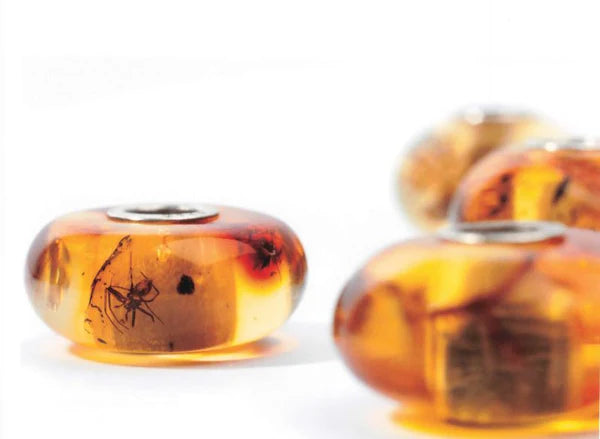
The gold of the north!
50 million years on the way to your bracelet. It is almost incomprehensible how long ago that is, but that specific moment in time is what we see. A ray of sunlight caught in a piece of amber and fitted with sterling silver. Since ancient times amber has been cherished for its beauty, its stunning colours and its spectacular history. Amber is also known as the Nordic Gold. You can find amber all over the world, and the occurrences are slightly different dependent on age and tree sort. Most of the Trollbeads amber is from the Baltic Sea. Throughout history, from the Stone Age to the Bronze Age, amber has been especially popular in jewellery and amulets for good lucks, and it has even been used in medicine.
The material
Amber is an organic material made from fossilized tree resin, which comes from pine trees. When the stem of a tree is damaged, the resin will seep from it and eventually end up on the forest floor. Over time the resin hardens and after several million years it turns into the material we know as amber.
The composition, colour, and other characteristics of amber vary according to age, sediment conditions, and the type of tree the resin comes from. The colours of amber range from light cognac to dark cherry and even black, and from milky to antique. Green and blue amber can also occur. You can find both transparent and opaque amber.
The weight of the amber is very low, and amber travels with the seaweed. In stormy weather, the waves bring the amber from the seabed and wash it up on the beaches together with seaweed, pieces of wood and mussel shells. So, the best time to look for amber on the beach is after a storm. Besides washing in by the sea, amber is also found hidden in the ground.
Amber’s mineral hardness is just a little harder than a fingernail. Due to its softness, it is of great importance that the artisans working with this material are truly skilled and gentle.
Caught in sticky resin
Inclusions in amber are small insects or plants that were caught in sticky resin millions of years ago. 80% of the insects are flies, mosquitoes and ants, but in rare cases, small spiders can also be found. You are very lucky if you find a piece of amber with an inclusion inside. The fossils found in amber are three-dimensional and are therefore considered to be the best-preserved evidence of early life. You could say

Craftsmanship
The first step of creating the amber bead is done by nature when the small pieces of amber are shaped by roughly sanding the edges and making the amber rounder. Hereafter, all Trollbeads amber beads are delicately made by hand. Each bead is individually sanded, shaped, and polished. Then a small hole is drilled in the centre of the roughly shaped amber, and through many steps skilled jewellers are now making it into a beautiful bead, carefully using small and delicate tools. Finally, it is time to insert the silver core and now the bead is ready to shine on your bracelet.





